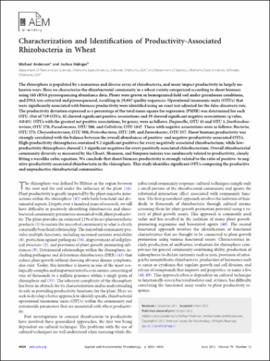| dc.contributor.author | Anderson, Michael | |
| dc.contributor.author | Habiger, Joshua | |
| dc.date.accessioned | 2018-08-29T14:24:33Z | |
| dc.date.available | 2018-08-29T14:24:33Z | |
| dc.date.issued | 2012-06 | |
| dc.identifier | oksd_anderson_characterizatio_2012 | |
| dc.identifier.citation | Anderson, M., & Habiger, J. (2012). Characterization and identification of productivity-associated rhizobacteria in wheat. Applied and Environmental Microbiology, 78(12), 4434-4446. https://doi.org/10.1128/AEM.07466-11 | |
| dc.identifier.uri | https://hdl.handle.net/11244/301611 | |
| dc.description.abstract | The rhizosphere is populated by a numerous and diverse array of rhizobacteria, and many impact productivity in largely unknown ways. Here we characterize the rhizobacterial community in a wheat variety categorized according to shoot biomass using 16S rRNA pyrosequencing abundance data. Plants were grown in homogenized field soil under greenhouse conditions, and DNA was extracted and pyrosequenced, resulting in 29,007 quality sequences. Operational taxonomic units (OTUs) that were significantly associated with biomass productivity were identified using an exact test adjusted for the false-discovery rate. The productivity deviation expressed as a percentage of the total mean square for regression (PMSR) was determined for each OTU. Out of 719 OTUs, 42 showed significant positive associations and 39 showed significant negative associations (q value, </=0.05). OTUs with the greatest net positive associations, by genus, were as follows: Duganella, OTU 43 and OTU 3; Janthinobacterium, OTU 278; Pseudomonas, OTU 588; and Cellvibrio, OTU 1847. Those with negative associations were as follows: Bacteria, OTU 273; Chryseobacterium, OTU 508; Proteobacteria, OTU 249; and Enterobacter, OTU 357. Shoot biomass productivity was strongly correlated with the balance between the overall abundances of positive- and negative-productivity-associated OTUs. High-productivity rhizospheres contained 9.2 significant positives for every negatively associated rhizobacterium, while low-productivity rhizospheres showed 2.3 significant negatives for every positively associated rhizobacterium. Overall rhizobacterial community diversity as measured by the Chao1, Shannon, and Simpson indexes was nonlinearly related to productivity, closely fitting a wavelike cubic equation. We conclude that shoot biomass productivity is strongly related to the ratio of positive- to negative-productivity-associated rhizobacteria in the rhizosphere. This study identifies significant OTUs composing the productive and unproductive rhizobacterial communities. | |
| dc.format | application/pdf | |
| dc.language | en_US | |
| dc.publisher | American Society for Microbiology | |
| dc.rights | This material has been previously published. In the Oklahoma State University Library's institutional repository this version is made available through the open access principles and the terms of agreement/consent between the author(s) and the publisher. The permission policy on the use, reproduction or distribution of the material falls under fair use for educational, scholarship, and research purposes. Contact Digital Resources and Discovery Services at lib-dls@okstate.edu or 405-744-9161 for further information. | |
| dc.title | Characterization and identification of productivity-associated rhizobacteria in wheat | |
| osu.filename | oksd_anderson_characterizatio_2012.pdf | |
| dc.description.peerreview | Peer reviewed | |
| dc.identifier.doi | 10.1128/AEM.07466-11 | |
| dc.description.department | Plant and Soil Sciences | |
| dc.description.department | Statistics | |
| dc.type.genre | Article | |
| dc.type.material | Text | |
| dc.subject.keywords | wheat | |
| dc.subject.keywords | rhizobacteria | |
